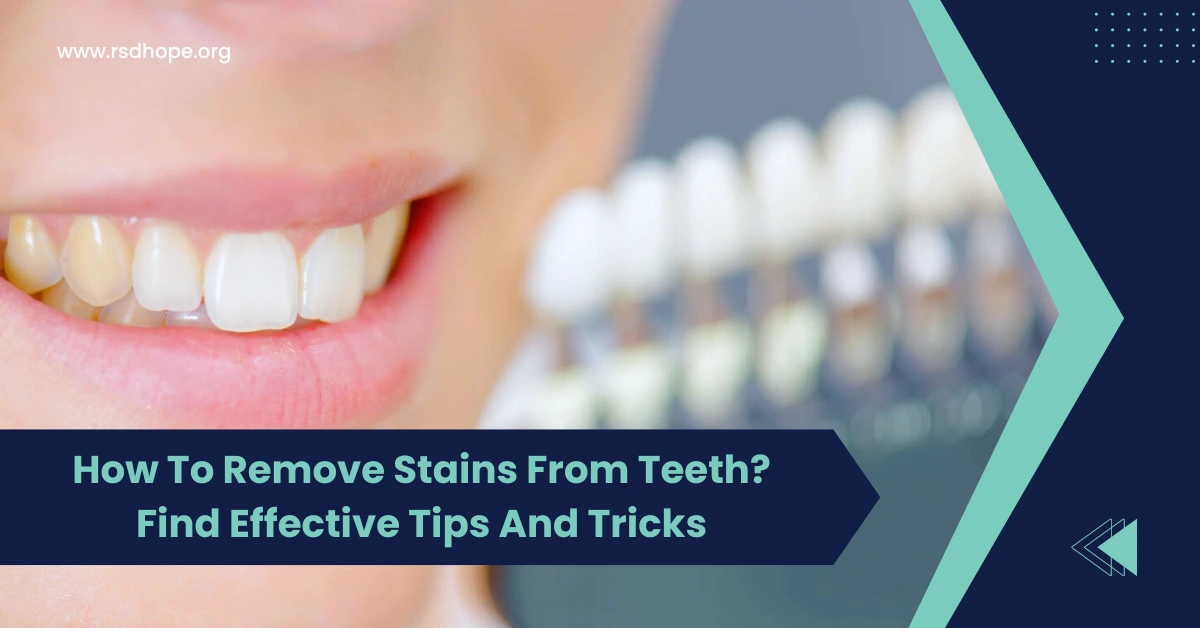Teeth staining is a common concern that affects many people, causing discoloration and impacting the appearance of their smile. This blog post will explore the various causes of teeth stains, the different types of stains, effective methods for removing them, and tips on how to prevent staining in the future. By understanding these factors, you can take steps towards achieving and maintaining a brighter, healthier smile.
Key Takeaways
- Teeth stains can be caused by consuming dark-colored beverages, smoking, poor oral hygiene, and certain medications.
- Stains are categorized as extrinsic (on the surface) or intrinsic (within the tooth).
- Removal methods include professional whitening, over-the-counter products, natural remedies, and regular dental cleanings. Causes of Stains on Teeth
Several factors contribute to the development of teeth stains. One of the most common causes is the consumption of dark-colored beverages like coffee, tea, and red wine. These drinks contain pigments that can adhere to the tooth enamel, leading to discoloration over time. Smoking is another significant culprit, as the nicotine and tar in tobacco products can cause yellowing of the teeth.
Poor oral hygiene practices, such as not brushing and flossing regularly, can also result in staining. When plaque and tartar accumulate on the teeth, they can attract and hold onto stain-causing substances. Additionally, certain medications, such as tetracycline antibiotics, can cause intrinsic staining when taken during tooth development in childhood.
Also Read: Can Wisdom Teeth Cause Headaches? Unlocking The Link!
Types of Teeth Stains
Teeth stains can be classified into two main categories: extrinsic and intrinsic stains. Extrinsic stains are those that occur on the surface of the teeth and are caused by external factors like food, drinks, and tobacco use. These stains can often be removed with proper cleaning and whitening techniques.
On the other hand, intrinsic stains are those that form within the tooth structure itself. These stains may be the result of genetic factors, aging, or exposure to certain medications during tooth development. Intrinsic stains are generally more challenging to remove and may require more advanced whitening treatments or dental procedures.
How to Remove Stains from Teeth?
There are several methods available for removing stains from teeth, depending on the type and severity of the discoloration. One of the most effective options is professional teeth whitening, which can be performed in a dental office or through take-home kits provided by a dentist. These treatments use high-concentration bleaching agents to break down and remove stains.
Over-the-counter whitening products, such as whitening toothpaste, strips, and gels, can also be effective for removing minor surface stains. These products typically contain lower concentrations of bleaching agents compared to professional treatments and may require longer use to achieve noticeable results.
Natural remedies, like brushing with baking soda or using hydrogen peroxide rinses, have gained popularity as alternative methods for teeth whitening. While these remedies can help remove some surface stains, they may not be as effective as professional or over-the-counter treatments.
Regular dental cleanings performed by a dental professional are also crucial for removing stains and maintaining a bright smile. During these cleanings, the dentist or hygienist will use specialized tools to remove plaque, tartar, and surface stains that regular brushing and flossing may miss.
How to Prevent Teeth Staining?
Preventing teeth staining involves adopting good oral hygiene habits and making lifestyle changes to minimize exposure to stain-causing substances. Here are some tips to help prevent teeth staining:
- Brush your teeth twice a day with fluoride toothpaste and floss daily to remove plaque and food particles.
- Limit your consumption of dark-colored beverages like coffee, tea, and red wine, or drink them through a straw to minimize contact with your teeth.
- Quit smoking or using tobacco products, as they are a significant contributor to teeth staining.
- Rinse your mouth with water after consuming stain-causing foods or drinks to help wash away pigments.
- Schedule regular dental check-ups and cleanings to remove built-up stains and maintain good oral health.
By incorporating these preventive measures into your daily routine, you can help keep your teeth looking bright and healthy.
Conclusion
Removing stains from teeth is possible through various methods, including professional whitening treatments, over-the-counter products, natural remedies, and regular dental cleanings. By understanding the causes and types of teeth stains, you can make informed decisions about which treatment options may work best for your specific needs.
Equally important is adopting good oral hygiene habits and making lifestyle changes to prevent future staining. Remember to consult with your dentist for personalized recommendations and guidance on achieving and maintaining a bright, healthy smile.
Read More: What To Eat After Wisdom Teeth Removal? Recovery Tips!
FAQs
A: The effects of professional teeth whitening can last anywhere from several months to a few years, depending on individual factors and maintenance.
A: Whitening toothpaste can help remove surface stains and gradually lighten teeth, but they are not as effective as professional whitening treatments.
A: When used as directed, most teeth whitening products are safe and do not damage tooth enamel. However, overuse or misuse can lead to tooth sensitivity or other issues.
A: It is generally recommended to have professional dental cleanings every six months to remove stains and maintain good oral health.
Sources:
- American Dental Association. (n.d.). Whitening. Retrieved from https://www.ada.org/en/member-center/oral-health-topics/whitening

